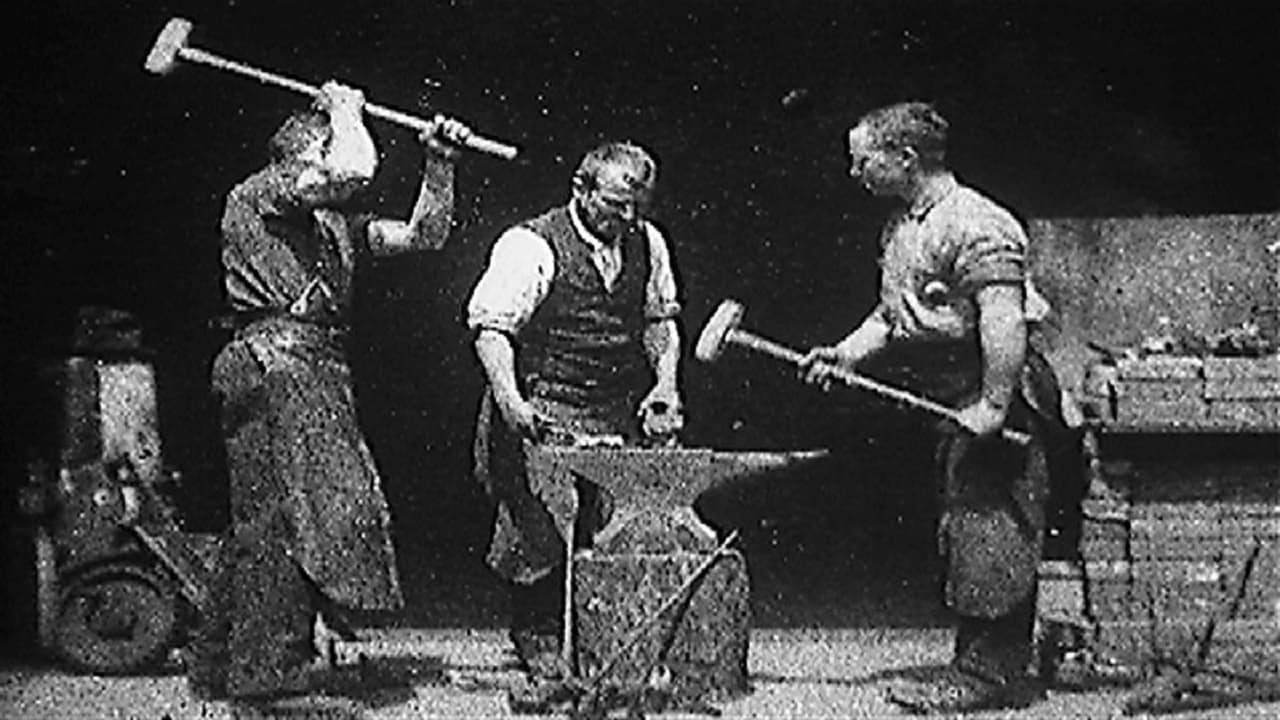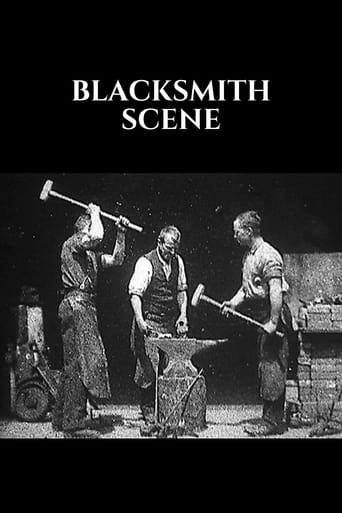kobe1413
William Heise and W.K.L. Dickson work together on this short of the Edison Manufacturing Company. It was the a scene of three men working as blacksmith. They all strike the iron between them, then they take a break as one man hands another a drink. This is celebrated as the first narrative scene ever committed to film.This was an important step forward for the Edison team as they had previously only filmed performers doing a routine, such as the "Newark Athlete", or filming themselves, such as the "Dickson Greeting". Here they purposely stage a scene in their studio so that they can make their audiences believe they are watching actual blacksmiths at work.I give a 2 out of 10, as it only really needed to be scene as a historical document.
John Seal
Men haven't changed much since Edison shot 'Blacksmith Scene' in 1893 (interestingly featuring the title card 'Blacksmith Scene #1' on the first volume of the Treasures From American Film Archives series--does this mean there was a sequel?). Here we get to enjoy thirty seconds of men pounding things: a glowing hot piece of metal on an anvil, an ice cold bottle of beer, and...well, you don't actually see them pounding anything else, but these are some pretty macho looking dudes and you can imagine what they enjoy doing on the weekend. It's not exactly the most exciting plot, but as this was the first dramatic film ever made, it only seems fair to cut it some slack. Too bad its double bill partner, a similar short focusing on horseshoes, doesn't seem to have survived.
Cineanalyst
This is one of the (at least) two films that the Edison Company exhibited in their nearly completed peephole viewer, the Kinetoscope, for the first time to the public at the Brooklyn Institute of Arts and Sciences on 9 May 1893. The other, which hasn't received comparable historical attention, was "Horse Shoeing" (1893). This historical importance is why the US Library of Congress has made it the earliest film selected to its National Film Registry. The Edison Company, headed by primary filmmakers and inventors William K.L. Dickson and William Heise, had been successfully producing films as early as 1890. Additionally, they had already given a public demonstration with a proto Kinetoscope on 20 May 1891 to some 150 members of the National Federation of Women's Clubs. The film shown was "Dickson Greeting", where Dickson tips his hat--he moves.The historical significance of primacy doesn't stop there for "Blacksmith Scene", though. Its May 1893 showing tested the Kinetoscope's commercial viability. On 14 April 1894, the first public Kinetoscope parlour opened in New York--their first commercial exhibition. Included among the 10 films that made up the original program was "Blacksmith Scene" (referred to as "Blacksmiths"). "Horse Shoeing" was there, too. Of the more interesting films also shown that day were: "Barber Shop" (1894), which was another interesting early use of the "Black Maria" as a (now) conventional studio set with a proto fictional narrative. And, "Sandow" (1894) flexing and posing in a loincloth offered an example of the voyeuristic and sexualized potential for the new medium--accentuated by the individualized peephole viewer. On 17 October of the same year, "Blacksmith Scene" (referred to as "Blacksmith Shop") was also part of the first Kinetoscope program in England.In addition to its primacy in the commercial exhibition of motion pictures, "Blacksmith Scene" is also a historically noteworthy film in how it's staged to form an artificial setting and fictional narrative. As primitive as it appears today, it was probably the most complex film made to date. Before its filming, Dickson and Heise had filmed brief displays of sport, such as boxing, which would prove a very popular subject in early American film. Other experiments such as "Dickson Greeting" (1891) and "A Hand Shake" (1892) were mere recordings of the motion of gestures and weren't released commercially. So too were the early experiments by others like Louis Le Prince and Woodsworth Donisthorpe. Thus, the history of film as a commercial industry begins with "Blacksmith Scene".Although with a slightly less restrictive definition of "motion pictures", one could argue that Eadweard Muybridge, Ottomar Anschütz, Émile Reynaud and others beat Thomas Edison to it. Nevertheless, this film is a departure from anything made before.The film, "Blacksmith Scene", consists of a stationary long shot lasting around half a minute of three blacksmiths who take a brief break from blacksmithing to pass around a bottle of beer. It's primitive--a silhouette of a man standing in front of the camera and on the left-hand side of the frame is briefly seen before, I assume, being told to move out of the picture. The trademark sunlit shadows and black background of the "Black Maria" become an overused setting in the early Edison films, but in regards to the time of this film, it wasn't hackneyed yet. Nevertheless, there are three actors (in actuality, employees of Edison who worked on the invention of the Kinetoscope) pretending to be blacksmiths, and they act out a fictional scene of blacksmithing.Moreover, as Charles Musser has pointed out, the film's narrative is nostalgic--recalling a bygone era when drinking while working was commonplace. In this sense, the film is a reconstruction of the past--something that the Edison Company would take further in "The Execution of Mary, Queen of Scots" (1895)."Blacksmith Scene" received widespread distribution--was, in fact, one of the first such films to be seen by many, and as such, was one of the earliest films to influence other filmmakers and to encourage remakes. The Lumière Company remade it as "Les Forgerons" (Blacksmiths at Work) in 1895. Also with the title "Blacksmiths at Work" is James Williamson's film made in 1898. The Edison Company, itself, remade it in 1895 (actually their third blacksmithing scene--the first being a now-lost experiment in 1891). Although not influenced by these commercial films (or vice versa), blacksmithing was also the subject of scientific analyses around this time in films of Albert Londe, as well as Étienne-Jules Marey and Charles Fremont.(Note: This is the second in a series of my comments on 10 "firsts" in film history. The other films covered are Traffic Crossing Leeds Bridge (1888), Annabelle Serpentine Dance (1895), The Execution of Mary, Queen of Scots (1895), La Sortie des usines Lumière (1895), L' Arroseur arose (1895), L' Arrivée d'un train à La Ciotat (1896), Panorama du Grand Canal vu d'un bateau (1896), Return of Lifeboat (1897) and Panorama of Eiffel Tower (1900).)
Boba_Fett1138
This early movie perfectly demonstrates the future possibilities of motion picture.The quality of the movie is surprising good looking. There are no jerky movements and the colors are clear to see, as is the entire picture as a whole. Sorts of makes you wonder why movies from the 1910's and '20's were so much worse looking compared to these early Edison Manufacturing Company films, from the end of the 19th century, when it comes down to the visual quality of the images. Of course it has to do everything with different (and cheaper and more simple to make) camera techniques and projecting being used, among other reasons.The movie shows three hard working blacksmiths hammering on an anvil, one at a time, each on a other side. When they're done they're thirsty and pass a bottle of beer, before resuming their work. Funny to see that the beer bottle itself was obviously empty. The third guy that got the bottle didn't even bothered to do as if he took a sip. He simply putted the bottle against his lips and then quickly putted it back on its place.It's a studio shot movie (shot at Black Maria studio at West Orange, New Jersey, America's first movie studio, built on the grounds of Edison's laboratories), meaning that the person's are 'actors' (actually of course just Edison employees) and the events are staged. The movie shows all of the possibilities of movie making. It has lots of individual movements from 3 separate persons and 'action' in it, since there are several things happening within the 30 seconds.I'm sure this movie must have really thrilled people to see all of the possibilities of motion pictures, when it was first publicly shown at the Brooklyn Institute in 1893.8/10http://bobafett1138.blogspot.com/

